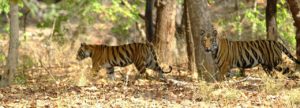
An ecosystem supporting abundance of flora & fauna
The Pench National Park and Tiger Reserve extends over an area of 257 sq. km. in the lower southern reaches of the Satpura hill ranges, along the northern boundary of Nagpur District. It was declared a National Park by the Government of Maharashtra in 1975 and received the official status of “Tiger Reserve of India” in February 1999.
The park gets its name from the Pench River, which meanders through it like a mammoth python, dividing it down the center. Rich in biodiversity, its terrain defined by hills, valleys and the occasional precipitous slope, Pench is an important ecosystem supporting an abundance of flora and fauna, including a rich variety of aquatic life.
Not surprisingly, the beauty of this part of central India has earned much literary attention. Poet Kalidas writes about the scenic charm of the place in his epics Meghdootam and Sakuntalam. R.A. Strendale’s “Camp in the Satpura Hills” draws a vivid pen picture of this idyllic paradise – as does Forsyth’s “Highlands of Central India”.
It is well known that the Jungle book of Rudyard Kipling is based on this woody forest and its rich wild life. An account of its natural assets and affluence cropped up in Ain-i-Akbari. Apart from this, this beautiful land and its varied flora and fauna find place in numerous books on natural history.
A tribal locale with copious natural resources and rich wild life is a recommended place for those who rejoice in the charisma of the woody forests and its wilderness.
Indeed, the Pench National Park is four different forest regions in one, an extravagance of trees, shrubs, grasses, climbers, weeds and herbs, with teak being the most prominent of the tree species. The park is home to 33 species of mammals, 164 species of birds, 50 species of fish, 10 species of amphibians, 30 species of reptiles, and a wide variety of insect life.
While primarily a reserve for tigers and panthers, Pench is also home to sambhar, chital, barking deer, nilgai, black buck, gaur, wild boar, chausingha, sloth bears, wild dogs, langurs, monkeys, mouse deer, black-naped hares, jackals, foxes, hyenas, porcupines, and flying squirrels, to name a few.
Here, birdlife is equally bountiful. The feathered denizens of Pench include both resident and migratory birds like Malabar pied hornbills, Indian pittas, ospreys, grey-headed fishing eagles, white-eyed buzzards, storks, waterfowls, four endangered vulture species, and the green pigeon, which is the State Bird.
Pench is a naturalist’s dream come true; a mind-expanding experience if ever there is one.
Flora: Ain, Bamboo, Haldu, Karu, Arjun, Tendu, Char.
Fauna: Tiger, leopard, sloth bear, wild dog, jackal, sambar, Indian bison, barking deer, blue bull, spotted deer, chausingha, ratel, flying squirrel, wild boar, langur, rhesus monkey, porcupine, pangolin, mouse deer.
Weather: There are three distinct seasons. Summer is from February to middle of June. The monsoon starts from mid-June and lasts till October. Winter starts in October with low temperatures in December/January.
Best time to visit is from February to April.
The Pench National Park is open to visitors from 1st October to 30th June each year and remains closed during the rainy season (July- Sept). Visiting hours are from 6 am to 11 am, and from 3 pm to 6 pm. Light vehicles and 15-seater buses are allowed, and speed restrictions must be followed.
How to reach:
By Air: Nagpur is the nearest airport 88 kms away. Takes 2 – 3 hrs by road. Jabalpur airport is 200 kms by road from Pench. Jabalpur is well connected with Delhi and Mumbai, and many other cities of India.
By Rail: Nagpur is the nearest railway station. Nagpur Junction is well connected with all cities of India.
By Road: Nagpur is only 88 kms from Pench via Seoni (NH No. 7). It is well connect with all the major cities of India.






